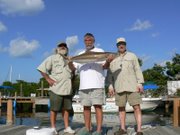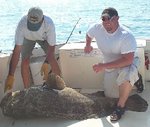What Kind of Fishing Gear Do You Need?

I am getting a lot of new customers from Europe this season. Traveling by air, it is a little tough packing all the fishing gear you think you will need. To make traveling a little easier here are a few tips for you guys.
90% of the fish I catch are on spinning tackle. A good twenty pound spinning outfit is a must for the Keys. To be what I consider good, the reel should hold at least 180 yards of clear monofilament line. A good drag is a must for the reel. While I don't use two piece rods, they are great for traveling. The rod length should not be over seven feet long. Fishing from boats with teetops, the longer rods are a pain. So stick with a six and one half to seven foot long spinning rod.
With this basic outfit, my customers have boated Sailfish to 90 pounds, Amberjack to 75 pounds, Tarpon to 150 pounds, Dolphin to 50 pounds, King Mackerel to 55 pounds, permit to 38 pounds and sharks over 400 pounds.
Lighter spinning outfits are lots of fun. Just make sure they have plenty of line capacity, 200 yards or more. Boating big fish on light tackle, under 15 pounds, is a big challenge. Not so much due to the fish over powering the gear, but due to obstacles in the water. Lobster pots, sea fans and bay grass cause a lot of fish to be lost. Just remember this before going very light.
If you don't want to pack your gear for the trip, good quality spinning outfits cost from 40 dollars. Renting gear locally is pretty much a waste of money when you can buy for the same or less. The lower end spinning outfits are throw aways. This means that they are fine for fishing, but the reels are more easily replaced than repaired. The quality of these outfits won't impress anyone, but they are fine for a couple of weeks in the Keys. By the way that 75 pound Amberjack pictured was caught on a cheap Shimano outfit.
If you are planning on trolling for tuna, wahoo and a shot at a marlin, a couple of heavier conventional trolling rods are in order. Forty to fifty pound outfits with plenty of line, four hundred yards or more are recommended. Shorter stand-up rods are the best for small boat fishing. Mine are five foot long with a long fore grip. A one piece rod is the only way to go in this case. The shorter length rod makes packing for your trip easier. A good drag system is a must for these reels and I do not recommend level wind reels. Braided line is getting popular with traveling anglers until they fish the Keys. Braid is fine for bottom fishing, but trolling it tends to be more of a problem than it is worth. Clear mono is more forgiving and versatile.
For fly fishermen a heavier weight rod is recommended in the winter with lighter for the summer because of wind conditions. A nine weight is a good all around choice. For bonefish and permit, epoxy crab patterns are the ticket. Mackerel hit the fairly large (three to five inch)Clouser and weighted streamer patterns with yellow, Chartreuse and blue/white good colors. These work well for dolphin offshore also. One fun fly to use is a red headed popper with white streamer. It drive mackerel, jacks and dolphin totally nuts. Tarpon like the large streamers, crab patterns and poppers though the sponge worm pattern is the hot fly around sponge worm time. If you are like most fly guys you will spend some time at the World Class Angler shopping for flies or getting ideas for tying your own. They have a good selection of flies and material for tying your own.
A simple four tray tackle bag will handle all the tackle you need. For trolling offshore, lures like C & H stubbies, Billy Bait Turbos are the best for all around trolling. Having a medium Islander (eight to ten inches)in the mix is a good idea. Basic colors that work well are blue and white, pink and white, red and black and dolphin color. Hook sizes for these lures should be from 5/0 to 8/0 with fairly light leaders of 50 to 100 pounds. In most cases, these are rigged with clear mono, but a short wire leader is a good idea for King Mackerel and Wahoo.
For inshore fishing, mainly natural baits are used. Light leaders and smaller hooks are the norm because of the clear water and the free lining fishing technique used. size 2 to 4/0 in straight J hooks or thin wire circle hooks are most common. Weights tend to be light in the keys with split shot and small egg sinkers from 1/8 ounce to one ounce all that is required. For deeper water bottom fishing larger sinker are needed on occasion. It is much easier to just buy the larger sinkers here than lugging them in from home.
Leader material should be kept to the light side. Light size three wire and twenty pound mono or flourocarbon is all you need most of the time. An exception is shark fishing where heavier wire and 80 to 100 pound mono is recommended and Tarpon fishing where fifty to sixty pound mono helps prevent chaffing.
For catching your own live bait, size 8 to ten bait hooks should be included. Sabiki rigs are recommend for catching Pichards, threadfin herring and cigar minnows. The Sabikis will work for pinfish, but I normally use only two to three hooks per rig for the pinfish.
To really catch bait a cast net with six foot or greater radius is handy. Packing one of these for your trip is a pain, but you can get one locally for around forty dollars. If you are staying for more than a week, it is worth the investment. Don't worry I can teach you to throw one in about ten minutes. Having the right live bait really improves your catch. Most of the best baits, Ballyhoo, Pilchards and Threadfin herring are not sold because they are difficult to keep alive. Catching your own is required and is the first thing I teach in my fishing 101 trips. Live shrimp, pinfish and crabs can be bought at any bait and tackle shop in season. The cost of the pinfish is pretty high and they are so easy to catch on your own why bother. Shrimp and crabs are the only live baits I would buy.
Lures for inshore fishing can be kept pretty simple. Fairly heavy spoons like a four inch Drone spoon, light jigs 1/8 to 1/2 ounce with Chartreuse being a very popular color, and four to six inch casing lures like Bomber long A's, Yozuri and Zara Spooks. Natural colors and the old reliable white with red head are your best bet. Count on losing a good deal of these lures. Soft lures in shrimp, crab and fish designs will get plenty of hits and torn up with nearly every fish.
To round out your tackle bag include gloves, needle nose pliers and a fillet knife.
If you are staying at Captain Pips, most of the basic gear like landing nets, gaffs, bait nets are available on site. So you can save luggage space by not bringing any of that.
The best piece of advice I can give you is keep it simple. Don't overload your boat with too many rods and tons of tackle you will never use.
Tight lines,
Enjoy some Marathon Heart of the Florida Keys Fishing
Captain Dallas


